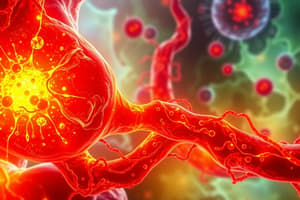Podcast
Questions and Answers
What is the main purpose of inflammation in living tissues?
What is the main purpose of inflammation in living tissues?
- To provide a complex biological response to injury (correct)
- To eliminate the need for immune response
- To decrease blood flow to affected areas
- To promote rapid tissue growth
Which suffix is commonly used to denote inflammation of an organ or tissue?
Which suffix is commonly used to denote inflammation of an organ or tissue?
- -oma
- -itis (correct)
- -opathy
- -osis
Which of the following cells are NOT typically involved in the inflammatory response?
Which of the following cells are NOT typically involved in the inflammatory response?
- Mast cells
- Macrophages
- Erythrocytes (correct)
- Neutrophils
What characterizes acute inflammation?
What characterizes acute inflammation?
Which condition is associated with chronic inflammation?
Which condition is associated with chronic inflammation?
What is one of the classical signs of inflammation?
What is one of the classical signs of inflammation?
What characterizes the vascular changes in acute inflammation?
What characterizes the vascular changes in acute inflammation?
What is an exudate?
What is an exudate?
What primarily causes edema during inflammation?
What primarily causes edema during inflammation?
What initiates the active anti-inflammatory mechanisms?
What initiates the active anti-inflammatory mechanisms?
Flashcards are hidden until you start studying
Study Notes
Inflammation
- Complex biological response to injury or harmful stimuli involving vascularized tissues.
- Induced by chemical mediators produced by host cells in response to injurious stimuli.
- Termed by adding "-itis" to the affected organ or tissue.
Significance of Inflammation
- Can cause life-threatening hypersensitivity reactions.
- Can cause progressive organ damage from chronic inflammation and subsequent fibrosis.
- Examples: Rheumatoid arthritis and atherosclerosis
Components of Inflammation
- Plasma fluid proteins.
- Circulating leukocytes: neutrophils, monocytes, eosinophils, lymphocytes, basophils, and platelets.
- Blood vessels.
- Connective tissue cells: mast cells, fibroblasts, macrophages, and lymphocytes.
- Extracellular matrix: Structural proteins (collagen, elastin), adhesive glycoproteins (fibronectin, laminin), and proteoglycans.
Types of Inflammation
- Acute inflammation: Early onset (seconds-minutes), short duration (minutes-days), fluid exudation (edema), polymorphonuclear leukocyte emigration (neutrophils).
- Chronic inflammation: Later onset (days), longer duration (weeks-years), inducing blood vessel proliferation and scarring, involving lymphocytes and macrophages infiltration.
Cardinal Signs of Inflammation
- Redness (rubor).
- Swelling (tumor).
- Heat (calor).
- Pain (dolor).
- Loss of function (functio laesa).
- More prominent in acute inflammation than in chronic inflammation.
General Characteristics of Inflammation
- Vascular wall response: Increased blood flow and vascular permeability.
- Inflammatory cell response: Leukocytes, macrophages, etc.
- Mediated by inflammatory mediators: Circulating plasma proteins and factors locally produced by vessel wall or inflammatory cells.
- Termination: Occurs when causative agents are eliminated and secreted mediators are removed.
Acute Inflammation: Vascular Changes
- Increased blood flow: Initial transient vasoconstriction followed by vasodilation (cause of heat and redness).
- Increased vascular permeability (vascular leakage): Leads to protein-rich fluid (exudate) escaping into extravascular tissue.
- Mechanisms of vascular leakage:
- Endothelial cell contraction (histamine, bradykinin, leukotrienes).
- Direct endothelial injury (burns, infections).
Acute Inflammation: Cellular Changes
- Leukocyte recruitment: Margination and rolling, adhesion, transmigration (diapedesis).
- Leukocyte activation: Stimulated by microbes, products of necrotic cells, and mediators.
Phagocytosis: Leukocyte Activation Process
- Recognition and attachment: Receptors on leukocytes recognize microbes and host proteins (opsonins).
- Engulfment: Formation of a phagocytic vacuole.
- Killing and degradation: Oxygen-dependent mechanisms (reactive oxygen and nitrogen species, lysosomal enzymes).
Examples of Inflammation Types
- Serous inflammation: Fluid called effusion in pleural, pericardial, and peritoneal cavities.
- Fibrinous inflammation: Increased vascular permeability, fibrinogen deposited in the extracellular space (meninges, pericardium, pleura).
- Suppurative (purulent) inflammation: Formation of pus, neutrophil infiltration, necrotic cells, edema, caused by bacteria (acute appendicitis).
- Pseudomembranous inflammation: Severe injury, extensive epithelial necrosis and sloughing, formation of a pseudo-membrane (Diphtheria).
Abscess
- Localized collection of purulent inflammatory exudates in tissue or organ.
- Central mass of necrotic leukocytes and tissue debris surrounded by preserved neutrophils.
- Can be walled off and replaced by connective tissue.
Ulcer
- Local defect or excavation of the surface of an organ caused by shedding inflammatory necrotic tissue.
- Common in:
- Inflammatory necrosis of mucosa-lined cavities (mouth, larynx, stomach).
- Subcutaneous inflammation of lower extremities in older adults with vascular defects.
Effects of Acute Inflammation
- Beneficial:
- Dilution of toxins by edema fluid.
- Production of antibodies.
- Fibrin network formation as a scaffold for inflammatory cells and limiting spread of infection.
- Harmful:
- Swelling and edema (acute epiglottitis).
- Increased tissue pressure leading to tissue necrosis.
- Digestion of viable tissue.
- Severe damage in allergic reactions.
- Generalized increased vascular permeability - shock (anaphylactic shock).
Studying That Suits You
Use AI to generate personalized quizzes and flashcards to suit your learning preferences.




